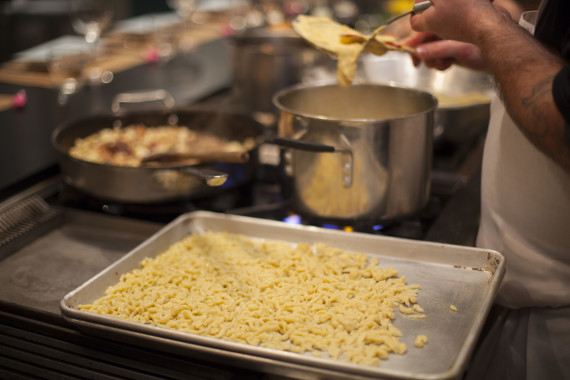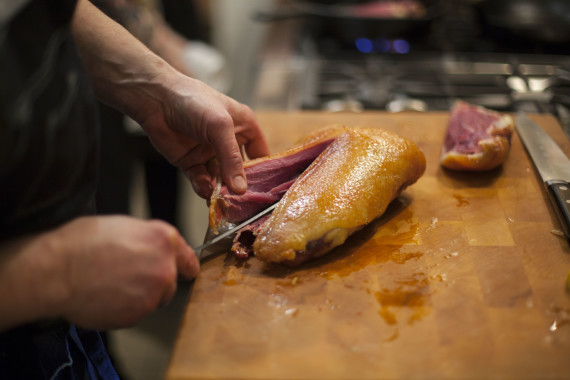The second month of 2019 is in the books. From a Chinese New Year dinner to an Italian-themed Valentine’s Day, February was full of flavorful and festive classes! We took a look back and gathered all of the best cooking tips and tricks from our visiting chefs and condensed them to these top five. Read on to learn a thing or two (or five) to add to your culinary arsenal!
Tip #1: Don’t “Caul” Me Fat

Joe Monnich of Stove & Tap made brussels sprouts “gulumpkis” in the COOK kitchen using an uncommon ingredient – caul fat. This pork fat is a membranous tissue that insulates and surrounds the stomach of the pig. Caul fat is lacy and thin so it will melt down while cooking. The webbed nature of the caul fat makes it perfect for wrapping and holding together anything you want to cook. Joe used the caul fat to wrap his pork belly stuffed Brussels sprouts, then baked them in the oven and seared them in a cast iron skillet.
Tip #2: Crispy Scrapple

Speaking of searing things off in a cast iron pan… Kelsey Bush, chef of the soon to open Bloomsday Café gave everyone a trick on achieving a crispy slice of scrapple. Before adding the scrapple slabs to her extremely hot pan, Kelsey dredged them with all purpose flour. Once they have a thin coating of flour Kelsey says they only need about a minute on each side in your searing hot cast iron until they are ready for a Pennsylvania Dutch breakfast of champions!
Tip #3: A Simple Simple Syrup Trick
According to AccuWeather, the bitter cold may persist into mid to late March. That calls for settling in and making yourself a nice cocktail at home. James Cleland of Boardroom Spirits shared a trick during his sour happy hour class that will assist you in your cocktail endeavors. Having a homemade simple syrup is an easy way to improve your cocktails. James says to use turbinado sugar or “sugar in the raw” for your simple syrup. His trick to making it last longer in your fridge is to add a bit of vodka to the mix since it has antibacterial properties.
Tip #4: No Spaetzle Press? No Problem!

While you’re bundled up inside drinking that cocktail, treat yourself to a bowl of warm and comforting spaetzle. All you need to make this German staple are eggs, flour, milk, and salt. Simple enough but wait, I don’t have a spaetzle press! Fear not, Nick Macri of La Divisa Meats showed us what kitchen utensil can double as a spaetzle press. Just push your dough through a perforated spoon to create the little dumplings.
Tip #5: When You Wish Upon A Duck

This winter you may have roasted a whole chicken or two, but what about duck? Ben Moore of Harper’s Garden gave our guests a tip on how to remove the wishbone from a duck. At the top of the body is where you’ll find the wishbone. Feel for where the bone is and make an incision above and below. Use your hand to free it up and yank it out. Removing the wishbone will make it much easier to break down the rest of your duck breast.
Back to Blog



